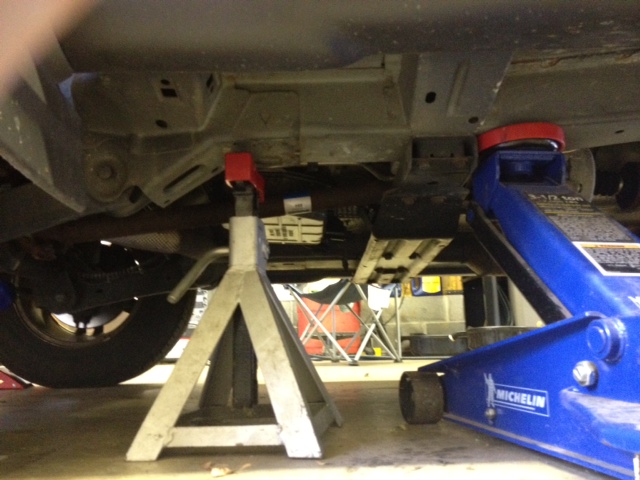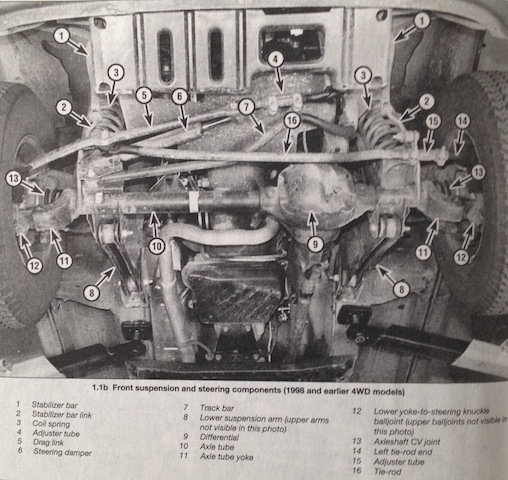Jeep Grand Cherokee 1993-1998: How to Replace Front Shocks
If your Jeep feels like a boat as you drive, it could be time to change your shocks. Here's how to change the front ones.
This article applies to the Jeep Grand Cherokee ZJ (1993-1998).
To break it down as simply as possible, the suspension system is in charge of doing two basic things: supporting the weight of the vehicle and controlling weight of the vehicle as it moves over various types of roads as well as terrain. Your springs are put in charge of supporting the weight, but as good as they are at doing this, they are horrible about controlling the weight. This is because the spring acts like an energy store. This means that as it compresses, energy is built up and that energy must be released, so it rebounds to release that energy. This is where the shock absorber—or as it is called in other parts of the automotive world the damper—steps in. It controls that compression and rebound; if it wasn't there to do that, the spring would just keep releasing the energy it keeps storing and you would just keep bouncing along down the road. If you have ever seen a car hit a bump on the road and just keep bouncing down the road, that is usually a car with bad or blown shock absorbers.
Just like with all the other parts on your vehicle, there will become a time when the shocks are at the end of their life or are worn out and must be changed out. On vehicles like Jeeps, where the shock is separate from the spring, it's actually not that difficult and the replacement can be performed by a person with basic mechanical knowledge as well as ability.

Materials Needed
- Standard socket sizes 7/16"-1"
- Ratchet
- Standard wrenches sizes 7/16"-11/16"
- Jack and jack stands
- Open-end wrench, locking pliers, or vise grips
- Penetrating oil
There are many different options out there when it comes to picking what shock absorber to purchase. It will depend on your budget and what you use your vehicle for to ultimately help you decide what direction to go. I can tell you from personal experience that there are differences between shock absorbers and it isn't just the price. The best thing you can do is make sure that you do adequate research to figure out which one will be the best for you and your vehicle.
Step 1 – Raise the vehicle and remove wheels
You will only need to raise and support the front of the vehicle because in this article we are only going over how to change the front shocks. Then you will only need to remove the front wheels of the vehicle.

Step 2 – Support the axle with a floor jack
After you are done removing the wheels. Take your floor jack and position under the axle tube (10 in Figure 2) nearest the shock that you will be removing first. You can't see the shocks in the image below, but they are located near the coil springs.

Step 3 – Remove shock absorber upper stem nut
The upper stem nut of the shock is located inside the engine compartment near the frame of the vehicle. In order to loosen the nut, you will need to keep the stem from turning. This can be accomplished by using an open-end wrench to hold the stem. You could also use a set of locking pliers or vise grips to hold the stem, as the flats for a wrench tend to be quite small. You may also want to spray the threads on the stem with penetrating oil and allow them to soak. The stem can tend to become rusty over time and this will make it very difficult to loosen the nut if this is the case. After you have removed the nut, you can also remove the washer and bushing that were under it.

Step 4 – Remove shock lower mounting bolts
The only thing still holding the shock in place are these two lower bolts. So once you have removed them, the shock absorber will be free to remove.

Step 5 – Install new shock
First, extend the new shock absorber as far as possible. Make sure to place a new washer and rubber bushing (that should be supplied with the new shock) onto the upper stem of the shock. Now guide the stem of the shock up into the upper mount where you had removed the old one from. Once it is through the upper mount, place a rubber bushing and washer on that end and thread the upper stem nut onto the stem. Make sure to wiggle the stem back and forth to make sure that the bushings have centered themselves within the hole of the upper mount. Now you can place the lower part of the shock in place and thread the bolts into their bolt holes. Make sure to tighten everything to the manufacturer's specifications. With the new shock installed, remove the stands from beneath your Jeep and lower it down.
Related Discussions
- How Can I Tell if Shock Needs Replacing? - CherokeeForum.com
- Shocks. What Do You Recommend? - CherokeeForum.com
- Bilstein Shock Replacement - CherokeeForum.com
- 2001 Grand Cherokee Shock Questions - CherokeeForum.com






